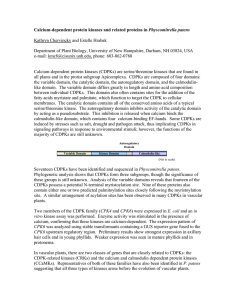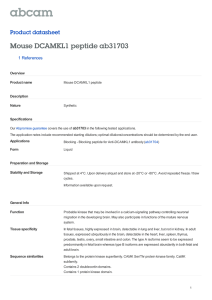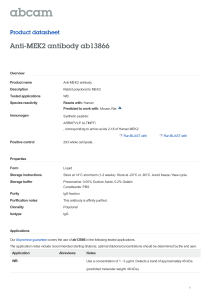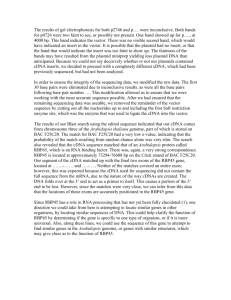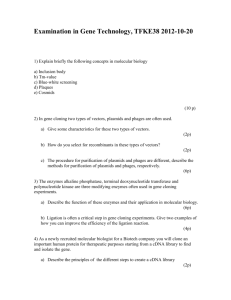Cloning of two chickpea cDNAs encoding calcium-dependent protein RESEARCH COMMUNICATIONS
advertisement
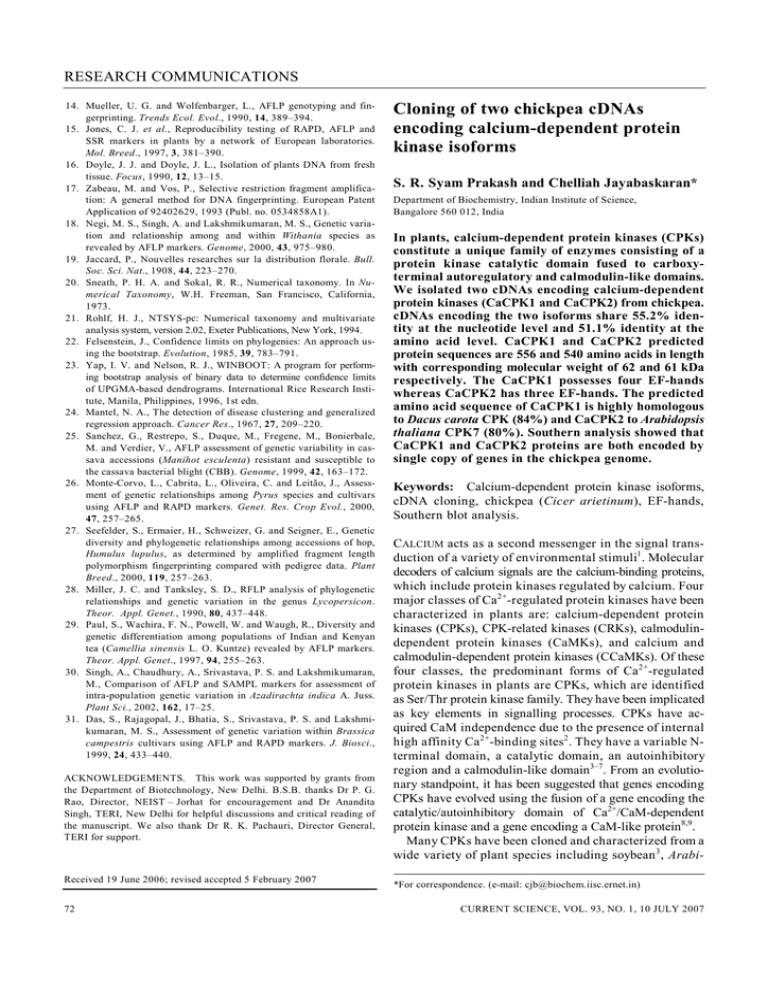
RESEARCH COMMUNICATIONS 14. Mueller, U. G. and Wolfenbarger, L., AFLP genotyping and fingerprinting. Trends Ecol. Evol., 1990, 14, 389–394. 15. Jones, C. J. et al., Reproducibility testing of RAPD, AFLP and SSR markers in plants by a network of European laboratories. Mol. Breed., 1997, 3, 381–390. 16. Doyle, J. J. and Doyle, J. L., Isolation of plants DNA from fresh tissue. Focus, 1990, 12, 13–15. 17. Zabeau, M. and Vos, P., Selective restriction fragment amplification: A general method for DNA fingerprinting. European Patent Application of 92402629, 1993 (Publ. no. 0534858A1). 18. Negi, M. S., Singh, A. and Lakshmikumaran, M. S., Genetic variation and relationship among and within Withania species as revealed by AFLP markers. Genome, 2000, 43, 975–980. 19. Jaccard, P., Nouvelles researches sur la distribution florale. Bull. Soc. Sci. Nat., 1908, 44, 223–270. 20. Sneath, P. H. A. and Sokal, R. R., Numerical taxonomy. In Numerical Taxonomy, W.H. Freeman, San Francisco, California, 1973. 21. Rohlf, H. J., NTSYS-pc: Numerical taxonomy and multivariate analysis system, version 2.02, Exeter Publications, New York, 1994. 22. Felsenstein, J., Confidence limits on phylogenies: An approach using the bootstrap. Evolution, 1985, 39, 783–791. 23. Yap, I. V. and Nelson, R. J., WINBOOT: A program for performing bootstrap analysis of binary data to determine confidence limits of UPGMA-based dendrograms. International Rice Research Institute, Manila, Philippines, 1996, 1st edn. 24. Mantel, N. A., The detection of disease clustering and generalized regression approach. Cancer Res., 1967, 27, 209–220. 25. Sanchez, G., Restrepo, S., Duque, M., Fregene, M., Bonierbale, M. and Verdier, V., AFLP assessment of genetic variability in cassava accessions (Manihot esculenta) resistant and susceptible to the cassava bacterial blight (CBB). Genome, 1999, 42, 163–172. 26. Monte-Corvo, L., Cabrita, L., Oliveira, C. and Leitão, J., Assessment of genetic relationships among Pyrus species and cultivars using AFLP and RAPD markers. Genet. Res. Crop Evol., 2000, 47, 257–265. 27. Seefelder, S., Ermaier, H., Schweizer, G. and Seigner, E., Genetic diversity and phylogenetic relationships among accessions of hop, Humulus lupulus, as determined by amplified fragment length polymorphism fingerprinting compared with pedigree data. Plant Breed., 2000, 119, 257–263. 28. Miller, J. C. and Tanksley, S. D., RFLP analysis of phylogenetic relationships and genetic variation in the genus Lycopersicon. Theor. Appl. Genet., 1990, 80, 437–448. 29. Paul, S., Wachira, F. N., Powell, W. and Waugh, R., Diversity and genetic differentiation among populations of Indian and Kenyan tea (Camellia sinensis L. O. Kuntze) revealed by AFLP markers. Theor. Appl. Genet., 1997, 94, 255–263. 30. Singh, A., Chaudhury, A., Srivastava, P. S. and Lakshmikumaran, M., Comparison of AFLP and SAMPL markers for assessment of intra-population genetic variation in Azadirachta indica A. Juss. Plant Sci., 2002, 162, 17–25. 31. Das, S., Rajagopal, J., Bhatia, S., Srivastava, P. S. and Lakshmikumaran, M. S., Assessment of genetic variation within Brassica campestris cultivars using AFLP and RAPD markers. J. Biosci., 1999, 24, 433–440. ACKNOWLEDGEMENTS. This work was supported by grants from the Department of Biotechnology, New Delhi. B.S.B. thanks Dr P. G. Rao, Director, NEIST – Jorhat for encouragement and Dr Anandita Singh, TERI, New Delhi for helpful discussions and critical reading of the manuscript. We also thank Dr R. K. Pachauri, Director General, TERI for support. Received 19 June 2006; revised accepted 5 February 2007 72 Cloning of two chickpea cDNAs encoding calcium-dependent protein kinase isoforms S. R. Syam Prakash and Chelliah Jayabaskaran* Department of Biochemistry, Indian Institute of Science, Bangalore 560 012, India In plants, calcium-dependent protein kinases (CPKs) constitute a unique family of enzymes consisting of a protein kinase catalytic domain fused to carboxyterminal autoregulatory and calmodulin-like domains. We isolated two cDNAs encoding calcium-dependent protein kinases (CaCPK1 and CaCPK2) from chickpea. cDNAs encoding the two isoforms share 55.2% identity at the nucleotide level and 51.1% identity at the amino acid level. CaCPK1 and CaCPK2 predicted protein sequences are 556 and 540 amino acids in length with corresponding molecular weight of 62 and 61 kDa respectively. The CaCPK1 possesses four EF-hands whereas CaCPK2 has three EF-hands. The predicted amino acid sequence of CaCPK1 is highly homologous to Dacus carota CPK (84%) and CaCPK2 to Arabidopsis thaliana CPK7 (80%). Southern analysis showed that CaCPK1 and CaCPK2 proteins are both encoded by single copy of genes in the chickpea genome. Keywords: Calcium-dependent protein kinase isoforms, cDNA cloning, chickpea (Cicer arietinum), EF-hands, Southern blot analysis. CALCIUM acts as a second messenger in the signal transduction of a variety of environmental stimuli1 . Molecular decoders of calcium signals are the calcium-binding proteins, which include protein kinases regulated by calcium. Four major classes of Ca 2+-regulated protein kinases have been characterized in plants are: calcium-dependent protein kinases (CPKs), CPK-related kinases (CRKs), calmodulindependent protein kinases (CaMKs), and calcium and calmodulin-dependent protein kinases (CCaMKs). Of these four classes, the predominant forms of Ca 2+-regulated protein kinases in plants are CPKs, which are identified as Ser/Thr protein kinase family. They have been implicated as key elements in signalling processes. CPKs have acquired CaM independence due to the presence of internal high affinity Ca 2+-binding sites2 . They have a variable Nterminal domain, a catalytic domain, an autoinhibitory region and a calmodulin-like domain3–7. From an evolutionary standpoint, it has been suggested that genes encoding CPKs have evolved using the fusion of a gene encoding the catalytic/autoinhibitory domain of Ca2+/CaM-dependent protein kinase and a gene encoding a CaM-like protein8,9. Many CPKs have been cloned and characterized from a wide variety of plant species including soybean 3 , Arabi*For correspondence. (e-mail: cjb@biochem.iisc.ernet.in) CURRENT SCIENCE, VOL. 93, NO. 1, 10 JULY 2007 RESEARCH COMMUNICATIONS dopsis7 , maize10,11 , rice12,13 , mungbean 14 , potato15 , strawberry16, cucumber17, zucchini18 and tobacco19,20. There has been considerable progress in plant CPK studies from identifying the new isoforms and cloning corresponding genes to clarify their specific roles in signal transduction cascades involving plant growth and development, and various stress responses. In Arabidopsis6,7 and in rice21, it has been found that there are 34 and 29 CPK isoforms respectively. Different CPK isoforms in a given plant species may be distinct in their expression patterns and physiological functions. In this communication, we report the isolation and characterization of two cDNAs from chickpea that encode two CPKs (CaCPK1 and CaCPK2). These two isoforms are 556 and 540 amino acid residues in length respectively and 55% identical. The most notable differences in the primary structures of these two isoforms are the CaCPK1 has a 79 amino acid variable domain and CaCPK2 has a 63 amino acid variable domain. CaCPK1 contains four EF-hands whereas CaCPK2 has three EFhands. A cDNA library of chickpea (Cicer arietinum L. cv. Kabuli) stem constructed in a Uni-ZAP XR vector was a gift from Tom W. Okita (Washington State University, USA). For library screening, a rice CPK cDNA, OsCPK213 was randomly labelled with [α -32 P] dCTP using random primer labelling kit (Fermentas, Germany) and used as a probe to screen membrane lifts of 2 × 105 plaques grown in E. coli XL-1 Blue MRF′ cells. Hybridization and washing were performed as described previously17 . Of the five plaques affording positive signals, two of them were purified through two additional cycles of hybridization. The purified λZAP II clones were in vivo excised as pBluescript SK (–) phagemids and transformed into E. coli SOLR cells (Stratagene). The plasmids were sequenced and the two cDNAs were compared at both nucleic acid and amino acid levels by using PILEUP and GAP programs22 and found to be partial, lacking 5′ ends. To obtain 5′ terminal sequence of the two truncated clones, 5′ RACE was performed by using the FirstChoiceTM RLMRACE kit (Ambion, USA) according to the manufacturer’s instructions with sequence-specific reverse primers. The 5′ RACE products were cloned into pTZ57R T/A cloning vector (Fermentas) and sequenced. DNA sequencing was carried out by the dideoxy chain termination method23 using fluorescent nucleotides in an automated DNA sequencer, PRISMTM Ready Reaction DyeDeoxyTM Terminator Cycle Sequencer. For comparison and analysis of the sequence data the following programs were used: BLAST 24 , FASTA, GAP, MAP, SEQED and TRANSLATE of Genetics Computer Group (GCG), Wisconsin, version 7.022 . Multiple sequence alignment was performed using the ClustalW, European Bioinformatics Institute, at the ExPasy site (http://www.expasy.ch). Phylogenetic tree was created according to the neighbourjoining method clustering strategy25 . CURRENT SCIENCE, VOL. 93, NO. 1, 10 JULY 2007 Genomic DNA was isolated from chickpea seedling leaves26 . Ten microgram portions was digested with restriction enzymes EcoRI, HindIII, KpnI, BamHI and XbaI, electrophoresed through 0.8% (w/v) agarose gels and blotted under denaturing conditions on to Hybond N+ nylon membranes (Amersham). We used PCR amplified cDNA probes labelled with [α -32 P]-dCTP using a random primer labelling kit (Fermentas) as follows: CaCPK1 cDNA nucleotides 1–222 (5′-specific sequence corresponding to N-terminal variable domain) and CaCPK2 cDNA nucleotides 1–198 (5′-specific sequence corresponding to Nterminal variable domain). Hybridization was performed in a solution of 6 × SSC, 5 × Denhart’s reagent, 0.5% (w/v) SDS and 100 µg/ml denatured salmon sperm DNA. After overnight incubation at 56°C, the filters were washed twice with 2 × SSC containing 0.5% (w/v) SDS for 5 and 15 min respectively at room temperature, once with 0.1 × SSC containing 0.5% (w/v) SDS at 37°C for 30 min, once with 0.1 × SSC containing 0.5% (w/v) SDS at 68°C for 30 min and followed by a final wash with 0.1 × SSC at room temperature for 5 min. The filters were then dried and wrapped in a thin plastic bag before exposure to autoradiographic film. Sequence data have been deposited at the EMBL/ GenBank under accession numbers AY312268 for CaCPK1 and AY312269 for CaCPK2. A chickpea cDNA library constructed in Uni-ZAP XR vector 27 was screened by plaque hybridization with rice CPK cDNA (OsCPK2) as the probe. Two of the positive plaques were purified and in vivo excised as pBluescript phagemids and their inserts were completely sequenced. The cDNA insert of the first clone was found to be 1559 bp in length and consisted of a 1059 bp open reading frame without an initiating codon and terminating in an amber codon TGA. The cDNA insert of the second clone was found to be 1463 bp in length and consisted of a 1089 bp open reading frame without an initiating codon and terminating in a stop codon TAG. Since the reading frames of both clones did not begin with a methionine start codon and there was no 5′-untranslated region, these clones were considered to be partial ones. Additional sequences of 5′ ends of the cDNAs were obtained by 5′ RACE. Thus, the combined sequences of the partial clones and the 5′ RACE products were found to be 2228 and 2144 bp respectively for the two clones, and we designated the clones as CaCPK1 and CaCPK2. Full-length cDNA of CaCPK1 consists of 60 bp of 5′-untranslated region, 1668 bp of coding region, 481 bp of 3′-untranslated region and 19 bp of poly (A) tail, encoding a polypeptide of 556 amino acids with a calculated molecular weight of 62 kDa and an isoelectric point of 5.92. Full-length cDNA of CaCPK2 consists of 150 bp of 5′-untranslated region, 1620 bp of coding region, 353 bp of 3′-untranslated region and 21 bp of poly (A) tail, encoding a polypeptide of 540 amino acids with a calculated molecular weight of 61 kDa and an isoelectric point of 6.2. Two cDNA clones 73 RESEARCH COMMUNICATIONS are 55.2% identical at the nucleotide level. The 5′- and 3′-untranslated regions are highly diverse and show only 28.5 and 43.2% identities respectively. The deduced chickpea CaCPK1 and CaCPK2 proteins contain all the characteristics of a calcium-dependent protein kinase (Figure 1). The N-terminal variable domain consists of 79 amino acids in CaCPK1 and 63 amino acids in CaCPK2. The kinase catalytic domain is 276 residues in CaCPK1 and 262 residues in CaCPK2. The C-terminus of the predicted polypeptide of CaCPK1 contains a calmodulinlike domain consisting of 170 amino acids with four highly conserved Ca 2+-binding EF-hands, while CaCPK2 contains 184 amino-acid spanning calmodulin-like domain with three highly conserved Ca2+-binding EF-hands. An autoinhibitory junction domain of 31 amino acids in length joined the kinase domain and the calmodulin-like domain of both isoforms of CaCPKs. Comparison of the CaCPK1 and CaCPK2 sequences to other known CPK proteins in the databases showed that CaCPK1 is 84% homology to DcCPK from carrot (Figure 2 a)28 , 83% homology to NtCPK1 from tobacco19 , 80% homology to OsCPK2 from rice13 and 53% homology to AtCPK7 from Arabidopsis9 , while CaCPK2 has 80% homology to AtCPK7 from Arabidopsis8 , 66% homology to NtCPK1 from tobacco19 , 55% homology to OsCPK2 from rice13 and 50% homology to DcCPK from carrot 28 . In order to determine the functional relationship among CPK genes, a phylogenetic tree was created according to the neighbour-joining method clustering strategy25 , using ClustalW program with the deduced amino-acid sequences from cloned CPKs. This analysis included sequences from monocots and dicots (maize, rice, zucchini, tobacco, Arabidopsis, soybean, mungbean, strawberry, sweet potato and carrot), a moss (Tortula ruralis) and an alga (Chlamydomonas eugametos). Analysis of the phylogenetic tree revealed that this particular family of plant kinases could be divided into various subgroups. The various maize, rice and Arabidopsis CPK isoforms were found through the phylogram, with CaCPK1 being more closely related to DcCPK and NtCPK1 with CaCPK2 coming in a separate subgroup with more close relative- Figure 1. Schematic diagram showing the four predicted structural domains in CaCPK1 and CaCPK2. Numbers denote the positions of amino-acid residues. N, Amino-terminal variable domain; K, Kinase domain; A, Autoinhibitory domain; CaM, Calmodulin. The bars within the CaM-like domain represent the EF-hand Ca 2+ -binding sites. 74 ness to AtCPK7 (Figure 2 b). The distribution of different members of the CPK family from a given species among the different groups suggests that the group might have different function(s), and CPK within a group might have similar function(s). Since CaCPK1 and CaCPK2 come in different groups, it is likely that these isoforms could perform different functions in chickpea. In order to examine the copy number of CaCPK1 and CaCPK2 genes in the chickpea genome, Southern blot analysis was performed using isoform-specific probes. For Southern blot analysis of CaCPK1, chickpea genomic DNA was digested with EcoRI, HindIII, KpnI and XbaI that do not cut the variable domain of CaCPK1 cDNA, and BamHI that cut the variable domain of CaCPK1 cDNA once. One band was detected in the DNA digested with EcoRI, HindIII, KpnI and XbaI and two bands were detected in the DNA digested with BamHI (Figure 3 a), suggesting that a single copy CaCPK1 gene is present in the chickpea genome. For Southern blot analysis of CaCPK2, the genomic DNA was digested with EcoRI, HindIII, KpnI and BamHI that do not cut the variable domain of CaCPK1 cDNA. One band each was detected in the DNA digested with EcoRI, HindIII, KpnI and two bands were detected in the DNA digested with BamHI even though there was no restriction site in the variable domain of CaCPK2 cDNA probe used for hybridization (Figure 3 b). This is because of the presence of an intronic region having BamHI restriction site in the variable domain of CaCPK2 gene. These results suggested that only one copy of CaCPK2 gene is present in the genome of chickpea. Recently, it has been demonstrated that the CPK cascades play important roles in stress responses in plants. Expression of OsCPK7, a rice CPK was induced by cold and salinity in both shoots and roots of 10-day-old rice seedlings29. When the OsCPK7 was overexpressed in rice, plants showed increased tolerance to cold and salt30 . The response of CPK gene expression to various stresses varied among individual members. For example, AtCPK10 and AtCPK11 are involved in mediating drought and salt stress signalling; while AtCPK30 (AtCPK1a) is involved in cold, salt and abscisic acid (ABA)-induced pathways31. Nicotiana tabacum CPKs – NtCPK2 and NtCPK3 – two CPK genes from tobacco, are involved in mediating defense and osmotic stress signalling pathways whereas NtCPK1 mediates an array of signals including GA3, ABA, cytokinin, wounding, fungal elicitors and salt stress32,33. We have recently reported that CaCPK1 was expressed in all tissues examined and is induced in response to salt, fungal spore and BA treatments; while CaCPK2 was almost undetectable in flowers and fruits and is induced by dehydration stress, BA and GA3 treatments, suggesting a function for these CaCPK1 and CaCPK2 isoforms in the corresponding signalling pathways34 . It is worthy of mention that autophosphorylation and phosphorylation of histone III-S by the purified recombinant CaCPK1 and CaCPK2 produced35 in E. coli occurred only in the presCURRENT SCIENCE, VOL. 93, NO. 1, 10 JULY 2007 RESEARCH COMMUNICATIONS Figure 2. Sequence comparison of CaCPK1 and CaCPK2 with other plant CPKs. a, Alignment of the deduced amino-acid sequences of CaCPK1 and CaCPK2 with other plant CPK proteins. Asterisks denote positions of identical amino acids. Single or double dots represent similar amino acids. Gaps, indicated by dashes (---) were introduced to maximize alignment. Diagnostic kinase sequences (A, B and C) and junction regions (J) are grayed and EF-hands are boxed. The EMBL database accession numbers of CaCPK1, CaCPK2 and other plant CPKs used for alignment are as follows: Cicer arietinum (CaCPK1, AY312268; CaCPK2, AY312269); Oryza sativa (OsCPK2, X81394); Nicotiana tabacum (NtCPK1, AF072908); Dacus carota (DcCPK, X56599) and Arabidopsis thaliana (AtCPK7, U31836). Sequences were aligned by ClustalW program located at ExPasy site (http://www.expasy.ch). b, A rooted phylogenetic tree of CPK proteins illustrating the relationship between the cloned plant CPKs. The phylogenetic tree was constructed using neighbour-joining method25 . Numbers indicate the per cent bootstrap replicates supporting the node. Root of the tree is arbitrarily placed. CaCPK1 and CaCPK2 are highlighted by box. Accession numbers of CPK sequences used to generate the phylogenetic tree are as follows: A. thaliana (AtCPK1, L14771; AtCPK2, U31833; AtCPK5, U31834; AtCPK6, U31835; AtCPK7, U31836; AtCPK9, U31751; AtCPK11, D21806; AtCPK12, U20388); Zea mays (ZmCPK1, D84408; ZmCPK2, U28376; ZmCPK10, ZMA7366); O. sativa (OsCPK1, AF319481; OsCPK2, X81394; OsCPK11, X81393; OsCPK12, AF048691); Glycine max (GmCPK, M64987); Cucurbita pepo (CpCPK1, U90262); Cucumis sativus (CsCPK, AY027885); Vigna radiata (VrCPK1, U08140); D. carota (DcCPK, X56599); Ipomea batatus (IbCPK, D87707); N. tabacum (NtCPK1, AF072908); Tortula ruralis (TrCPK1, U82087); Chlamydomonas eugametos (CeCPK1, Z49233), and this work, C. arietinum (CaCPK1, AY312268; CaCPK2, AY312269). CURRENT SCIENCE, VOL. 93, NO. 1, 10 JULY 2007 75 RESEARCH COMMUNICATIONS Figure 3. Genomic southern blot analyses of CaCPK1 (a) and CaCPK2 (b) genes. Aliquots (15 µg) of chickpea genomic DNA were digested with EcoRI (E), HindIII (H), KpnI (K), BamHI (B) and XbaI (X), electrophoresed on 0.8% (w/v) agarose gels, transferred onto nylon membranes and hybridized with the cDNA probes corresponding to the N-terminal variable domain of CaCPK1 (residues 1–222) or CaCPK2 (residues 1–198). The position of DNA standards is indicated on the left and their size is given in kb. ence of Ca2+. It has also been demonstrated that they differ in their kinetic and Ca2+ binding properties35 . The major challenge of the future will be to overexpress the CaCPK1 and CaCPK2 in chickpea lines to confer salt and drought tolerance, and/or resistance to fungal pathogens in transgenic chickpea plants. 1. Bush, D., Calcium regulation in plant cells and its role in signalling. Annu. Rev. Plant Physiol. Plant Mol. Biol., 1995, 46, 95–122. 2. Roberts, D. M. and Harmon, A. C., Calcium-modulated proteins: Targets of intracellular calcium signals in higher plants. Annu. Rev. Plant Physiol. Plant Mol. Biol., 1992, 43, 375–414. 3. Harper, J. F., Sussman, M. R., Schaller, G. E., Putnam-Evans, C., Charbonneau, H. and Harmon, A. C., A calcium-dependent protein kinase with a regulatory domain similar to calmodulin. Science, 1991, 252, 951–954. 4. Suen, K. L. and Choi, J. H., Isolation and sequence analysis of a cDNA clone for a carrot calcium-dependent protein kinase: Homology to calcium/calmodulin-dependent protein kinases and to calmodulin. Plant Mol. Biol., 1991, 17, 581–590. 5. Huang, J.-F., Teyton, L. and Harper, J. F., Activation of a Ca 2+ dependent protein kinase involves intramolecular binding of a calmodulin-like regulatory domain. Biochemistry, 1996, 35, 13222– 13230. 6. Cheng, S. H., Willmann, M. R., Chen, H. C. and Sheen, J., Calcium signalling through protein kinases. The Arabidopsis calciumdependent protein kinase gene family. Plant Physiol., 2002, 129, 469–485. 7. Hrabak, E. M., Chan, C. W. M., Gribskov, M., Harper, J. F., Choi, J. H. and Halford, N., The Arabidopsis CDPK-SnRK superfamily of protein kinases. Plant Physiol., 2003, 132, 666–680. 8. Harmon, A. C., Gribskov, M. and Harper, J. F., CDPKs-a kinase for every Ca 2+ signal? Trends Plant Sci., 2000, 5, 154–159. 9. Hrabak, E. M., Calcium-dependent protein kinases and their relatives. Adv. Bot. Res., 2000, 32, 185–223. 10. Estruch, J. J., Kadwell, S., Merlin, E. and Crossland, L., Cloning and characterization of a maize pollen-specific calcium-dependent calmodulin-independent protein kinase. Proc. Natl. Acad. Sci. USA, 1994, 91, 8837–8841. 76 11. Wang, L., Liang, S. and Lu, Y.-T., Characterization, physical location and expression of the genes encoding calcium/calmodulindependent protein kinases in maize (Zea mays L.). Planta, 2001, 213, 556–564. 12. Kawasaki, T., Hayashida, N., Baba, T., Shinozaki, K. and Shimada, H., The gene encoding a calcium-dependent protein kinase located near the Sbel gene encoding starch branching enzyme-I is specifically expressed in developing rice seeds. Gene, 1993, 129, 183–189. 13. Breviario, D., Morello, L. and Giani, S., Molecular cloning of two novel rice cDNA sequences encoding putative calcium-dependent protein kinases. Plant Mol. Biol., 1995, 27, 953–967. 14. Botella, J. R., Arteca, J. M., Somodevilla, M. and Arteca, R. N., Calcium-dependent protein kinase gene expression in response to physical and chemical stimuli in mungbean (Vigna radiata). Plant Mol. Biol., 1996, 30, 1129–1137. 15. 5DÕ¶FHV 0 &KLFR - 0 7HOOH] -Inon, M. T. and Ulloa, R. M., Molecular characterization of StCDPK1, a calcium-dependent protein kinase from Solanum tuberosum that is induced at the onset of tuber development. Plant Mol. Biol., 2001, 46, 591–601. 16. Llop-Tous, I., Dominguez-Puigjaner, E. and Vendrell, M., Characterization of a strawberry cDNA clone homologous to calciumdependent protein kinases that is expressed during fruit ripening and affected by low temperature. J. Expt. Bot., 2002, 53, 2283– 2285. 17. Kumar, K. G. S., Ullanat, R. and Jayabaskaran, C., Molecular cloning, characterization, tissue-specific and phytohormoneinduced expression of calcium-dependent protein kinase gene in cucumber (Cucumis sativus L.). J. Plant Physiol., 2004, 161, 1061–1071. 18. Ellard-Ivey, M., Hopkins, R. B., White, T. J. and Lomax, T. L., Cloning, expression and N-terminal myristoylation of CpCPK1, a calcium-dependent protein kinase from zucchini (Cucurbita pepo L.). Plant Mol. Biol., 1999, 39, 199–208. 19. Yoon, G. M., Cho, H. S., Ha, H. J., Liu, J. R. and Lee, H. P., Characterization of NtCDPK1, a calcium-dependent protein kinase gene in Nicotiana tabacum, and the activity of its encoded protein. Plant Mol. Biol., 1999, 39, 991–1001. 20. Zhang, M., Liang, S. and Lu, Y. T., Cloning and functional characterization of NtCPK4, a new tobacco calcium-dependent protein kinase. Biochim. Biophys. Acta, 2005, 1729, 174–185. 21. Asano, T., Tanak, N., Yang, G., Hayashi, N. and Komatsu, S., Genome-wide identification of the rice calcium-dependent protein kinase and its closely related kinase gene families: Comprehensive analysis of the CDPKs gene family in rice. Plant Cell Physiol., 2005, 46, 356–366. 22. Devereux, J., Halberli, P. and Smithies, O., A comprehensive set sequence analysis programs for the VAX. Nucleic Acids Res., 1984, 12, 387–395. 23. Sanger, F., Nicklen, S. and Coulson, A. R., DNA sequencing with chain terminating inhibitors. Proc. Natl. Acad. Sci. USA, 1977, 74, 5463–5467. 24. Altschul, S. F., Madden, T. L., Schaffer, A. A., Zhang, J., Zhang, Z., Miller, W. and Lipman, D. J., Gapped BLAST and PSIBLAST: A new generation of protein database search programs. Nucleic Acids Res., 1997, 25, 3389–3402. 25. Saitou, N. and Nei, M., The neighbour-joining method: A new method for reconstructing phylogenetic trees. Mol. Biol. Evol., 1987, 4, 406–425. 26. Glick, R. E., McCauley, S. W., Gruissem, W. and Melis, A., Light quality regulates expression of chloroplast genes and assembly of photosynthetic membrane complexes. Proc. Nat. Acad. Sci. USA, 1986, 83, 4287–4291. 27. Singh, S., Choi, S. B., Modi, M. K. and Okita, T. W., Isolation and characterization of cDNA clones encoding ADP-glucose pyrophosphorylase (AGPase) large and small subunits from chickpea (Cicer arietinum L.). Phytochemistry, 2002, 59, 261–268. CURRENT SCIENCE, VOL. 93, NO. 1, 10 JULY 2007 RESEARCH COMMUNICATIONS 28. Suen, K. L. and Choi, J. H., Isolation and sequence analysis of a cDNA clone for a carrot calcium-dependent protein kinase: Homology to calcium/calmodulin-dependent protein kinases and to calmodulin. Plant Mol. Biol., 1991, 17, 581–590. 29. Saijo, Y., Kinoshita, N., Ishiyama, K., Hata, S., Kyozuka and Hayakawa, T., A Ca 2+ -dependent protein kinase that endows rice plants with cold- and salt-stress tolerance functions in vascular bundles. Plant Cell Physiol., 2001, 42, 1228–1233. 30. Saijo, Y., Hata, S., Kyozuka, J., Shimamoto, K. and Izui, K., Over-expression of a single Ca 2+ -dependent protein kinase confers both cold and salt/drought tolerance on rice plants. Plant J., 2000, 23, 319–327. 31. Sheen, J., Ca 2+ -dependent protein kinases and stress signal transduction in plants. Science, 1996, 274, 1900–1902. 32. Romeis, T., Ludwig, A. A., Martin, R. and Jones, J. D. G., Calcium-dependent protein kinases play an essential role in a plant defense response. EMBO J., 2001, 20, 5556–5567. 33. Ludwig, A. A., Romeis, T. and Jones, J. D. G., CDPK-mediated signalling pathways: Specificity and cross-talk. J. Exp. Bot., 2004, 55, 181–188. 34. Prakash, S. R. S. and Jayabaskaran, C., Expression and localization of calcium-dependent protein kinase isoforms in chickpea. J. Plant Physiol., 2006, 163, 1135–1149. 35. Prakash, S. R. S. and Jayabaskaran, C., Heterologous expression and biochemical characterization of two calcium-dependent protein kinase isoforms CaCPK1 and CaCPK2 from chickpea. J. Plant Physiol., 2006, 163, 1083–1093. ACKNOWLEDGEMENTS. We are grateful to Prof. Tom W. Okita, Washington State University, Pullman, USA for providing cDNA library of chickpea; Dr Diego Breviario, Instituto Biosintesi Vegetali, Italy for OsCPK2 cDNA clone, and T. Selvaraj for his help in the preparation of the manuscript. This work was supported by a grant from the Department of Science and Technology, Government of India. S.R.S.P. is a recipient of a Research Fellowship from CSIR. Received 8 June 2006; revised accepted 21 November 2006 Delivery of N-methyltransferase and 11S globulin promoters of Coffea canephora Pex Fr. by tissue electroporation and analysis of transformational events Vinod Kumar, K. V. Satyanarayana, A. Ramakrishna, A. Chandrashekar and G. A. Ravishankar* Plant Cell Biotechnology Department, Central Food Technological Research Institute, Mysore 570 020, India A tissue electroporation system was optimized to deliver transgenes, and the expression of reporter gene driven by coffee N-methyltransferase (NMT) and 11S globulin promoters in somatic embryos of Coffea canephora was achieved. Plant transformation vector pCAMBIA 1301 was adopted for electroporation. Transient as well as stable expression of uidA gene was detected after *For correspondence. (e-mail: pcbt@cftri.res.in) CURRENT SCIENCE, VOL. 93, NO. 1, 10 JULY 2007 electroporation using field strengths of 500 V/cm, 900 µF capacitance and 100 µg/ml of plasmid DNA. The efficiency of tissue electroporation was dependent on the type and developmental stage of the plant material. Spermidine treatment during electroporation increased transformation frequency twofold. Histochemical staining of GUS activity confirmed the expression of uidA gene in somatic embryos and endosperm tissues of C. canephora. Electroporation with pPCGB 959 (11S globulin promoter) resulted in 32% of explants showing GUS expression in endosperm tissues. The study demonstrated the ability of these promoters to drive the expression of the reporter gene. The results may be helpful for using these promoters to alter the expression of the NMT gene family through transcriptional gene silencing by RNA-directed DNA methylation, and also for using 11S globulin promoter for silencing NMT genes in a tissue-specific manner in transgenic coffee plants. Keywords: Coffea canephora, 11S globulin promoter, N-methyltransferase, tissue electroporation. COFFEE is a woody perennial crop and requires 4–5 years to yield fruit. Coffea species contain caffeine, a purine alkaloid. Caffeine is known to accumulate in beans as well as in the leaves and embryos. The caffeine biosynthesis pathway involves the following steps, viz. xanthosine → 7-methylxanthosine → 7-methylxanthine → theobromine → caffeine as the major route to caffeine. The methylation steps are catalysed by N-methyltransferases (NMTs) that use Sadenosyl-l-methionine as the methyl donor 1 . The cDNAs encoding 7-methylxanthosine synthase, theobromine synthases and caffeine synthase2–4 have been cloned and are found to possess close similarity. We have recently cloned the promoter for one of the NMT genes5 and demonstrated reporter gene expression in Nicotiana tobacum. Similarly, the promoter for the seed-specific 11S globulin gene has been cloned6 . This has opened up new avenues for developing transgenic plants with down regulation of caffeine synthesis in a seed-specific manner. The 11S globulins are major seed storage proteins in coffee beans. These storage proteins are also found in low levels in somatic and zygotic embryos of coffee7 . Tissue-specific promoters such as 11S globulin could be good candidates to silence caffeine biosynthesis in a tissue-specific manner in the endosperm and embryos. As a prelude to this, it is essential to study the function of the isolated promoters in coffee tissues, especially in somatic embryos where caffeine is synthesized and down regulation of this pathway can be analysed in the early stage of transgenic plant development. Electroporation is a DNA delivery technique that utilizes a high-intensity electric pulse to create transient pores in the cell membrane and hence facilitates uptake of DNA. The simplicity and efficiency of DNA delivery into plant protoplasts by this technique8,9 has encouraged its application for targetting intact single cells as well as whole plant tissues10,11 . Tissue electroporation has been success77
